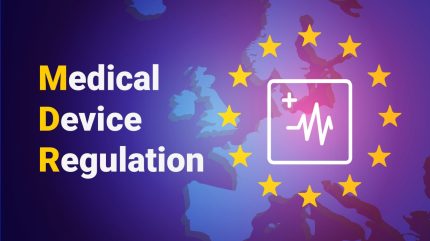
The European Union (EU) introduced its Medical Device Regulation (MDR) in 2017. Set forth as an update to the Medical Devices Directive (MDD) of 1992, the EU said at the time that the revised regulation was intended to amend problems with divergences in the interpretation and application of the previous regulation.
The MDR was also intended to bolster protections for public health and patient safety and to close gaps in the previous regulation to account for technological progress and incidents involving the malfunctioning of medical devices – a matter driven in large part by the Poly Implant Prothèse (PIP) silicone implant scandal, which came to light in 2010.
A staggered timeline currently exists for MDR compliance: the end of 2027 for high-risk devices and the end of 2028 for lower-risk devices and legacy medical devices while manufacturers had to fall into compliance with the MDR as of 26 May 2024.
Past research determined that the MDR would be effective in the EU’s goal of strengthening the internal market because it would centralise competencies at the EU level and therefore harmonise regulation, and that it would be unlikely to substantially interfere with innovation.
However, the undertakings involved in meeting the requirements of the MDR, reflect a less optimistic reality for contract research organisations (CROs) and the clients enlisting their services to navigate the regulation. While the MDR’s rationale is well-intentioned, challenges around adherence are resulting in problems for market participants and negative outcomes for the medtech space in Europe, due in part to a perceived lack of clarity around some of the requirements the regulation mandates.
Challenges also exist around a limited number of notified bodies designated by EU Member States to assess the conformity of medical devices that need to conform to the MDR. According to the European Commission (EC), there are around 500,000 medical devices on the EU market. This reality has resulted in a bottleneck in processing compliance applications.
How well do you really know your competitors?
Access the most comprehensive Company Profiles on the market, powered by GlobalData. Save hours of research. Gain competitive edge.

Thank you!
Your download email will arrive shortly
Not ready to buy yet? Download a free sample
We are confident about the unique quality of our Company Profiles. However, we want you to make the most beneficial decision for your business, so we offer a free sample that you can download by submitting the below form
By GlobalDataWhat has changed?
The changes the EU MDR bring versus the MDD impact some steps from a regulatory perspective around the lifecycle of a medical device brought to market in the EU.
Under the MDD, device data requirements centred around safety data — a case of showing the EU safety data in the context of a device’s anticipated use to receive its CE mark within the MDD framework.
“Registering a new device under the MDR is more complicated as much more data is needed,” says Mark Mayhew from Treehill Partners, a healthcare advisory that works with CROs.
“There’s now a focus on generating more efficacy data, and that requires more complex clinical studies, and CROs need to be on top of what requirements there are which were not previously in place.”
The MDR also encompasses operational elements, including packaging design changes, the addition of unique device identifiers (UDI), and companies registering themselves in the European database for medical devices (EUDAMED).
Mayhew continues: “Finally, there are changes to the actual supply, and the contracts to be generated with manufacturing suppliers, which need to be reflective of MDR requirements.”
Regarding transitioning products under the MDD to the MDR, Mayhew describes the process as having proven “mind-bogglingly complex”.
“In an area like ophthalmology, for example, companies may have hundreds of little devices that are sold in the marketplace; and they now not only have to change aspects including CE marks, the supply agreements for each of those contracts but also provide new data,” he says.
The new data requirements mean that companies need to generate certain datasets annually that must be made available to the regulator to demonstrate the efficacy and safety of their device.
“All of this put together has created a nightmare.”
Increased regulatory burden plus uncertainty
Beyond offering advisory services, Treehill also has experience in taking on operational roles within companies.
In this capacity, a key issue for the company has surrounded the MDR’s clarity over the transitioning of existing products.
Treehill CEO Ali Pashazadeh says that in its operational role, Treehill appointed a range of counsel, and when looking at the manufacturing, data, and labelling requirements of MDR, it was unclear what the regulatory ask was.
“The actual implementation of what was regulation required for transitioning an existing product to be compliant with the MDR was difficult for us as principles of an asset to navigate, and recently we have not been advising CROs on how to make that transition because every time we pointed them to a different lawyer or regulatory advisor in medtech, I think they were getting different advice,” says Pashazadeh.
CROs are at the front end in terms of developing and bringing medical devices to patients in the clinical evaluation context. Contract development and manufacturing organisations (CDMOs) have regulations to follow on the front end in terms of testing, but they also have regulations such as the International Organization for Standardization (ISO) that they need to follow. Under the MDR, CDMOs now also need to prepare all of their material for the updated regulations and CROs and CDMOs need to work together more closely than before, and Pashazadeh says the closeness and coordination of this relationship is more important than ever, particularly as certain regulatory requirements have not yet solidified.
To be able to press for accountability, Treehill enlisted a regulatory lawyer when entering a contract with a CDMO to have peace of mind over agreements and interpretation over dictates surrounding compliance under MDR.
“If we get it wrong tomorrow, we have a written piece of paper from a regulatory lawyer that says, this contract you’re entering into will be compliant, to the best of their knowledge, in 12 or 24 months,” says Pashazadeh.
“You shouldn’t need to go into that level of paranoia for a simple supply or manufacturing agreement.”
“Day to day, people need to understand what companies live through in order to remain compliant. And the question isn’t whether people should be compliant or not; rather, it is, do people know what they are being asked to be compliant with?”
A lack of notified bodies
Research by the notified body industry group Team-NB has found that there were 42 designated bodies in 2023 to handle the workload of the MDR in recertifying existing medical devices and processing any new applications for CE marking.
“Companies are not just dropping products because the return on the investments that they have to make, from a regulatory maintenance point of view, is not worth it, they are also losing the commercial value of their devices because it’s taking an extra year or more to come to market, based on the backlog of work at the notified body,” says Mayhew.
“The other thing is that notified bodies have the discretion to interpret MDR in their own way, and it seems that not all the notified bodies may interpret the regulations in exactly the same way, which leaves a high potential for extra confusion.”
The impact of the MDR on Europe’s medtech space
“We’ve been seeing very little client demand for the EU MDR route,” says Meri Beckwith, co-founder of CRO Lindus Health.
Describing the MDR as a “disaster”, Beckwith says that as a CRO, Lindus Health aims to make running clinical studies to help companies gain marketing authorisation for medical devices extremely fast and simple.
“You would think that we would be pro-regulation, but I have to say, in the case of the MDR, the requirements are so onerous and opaque that it’s essentially killed the market opportunity in Europe for a lot of companies.”
“Overwhelmingly, every kind of medical device company I know of is now banking on a US route to market, whether that be through the US Food and Drug Administration’s (FDA) 510(k) or de novo pathways.”
Beckwith also points out that as the MDR is a big step up from the MDD in terms of stringency, level of clinical evidence and post-market surveillance required, the difference and impact are biggest on lower-risk devices, presenting a considerable barrier for smaller companies who are more likely to develop the most innovative devices.
“These factors simply make the EU a very unattractive place to develop and commercialise a medical device product. EU consumers and patients above all lose out, as many device companies reasonably focus on the US and other markets,” Beckwith concludes.
Treehill’s Mark Mayhew adds that CE marking under the MDD was relatively straightforward and meant that a lot of medical devices were coming to market in Europe first.
“Europe has historically been innovative in terms of welcoming new devices, whereas the US was always stricter in that sense. Taking the ophthalmic space as an example, Europe was where all the innovative intraocular lenses came first, and there are far more approved in Europe than in the US. But that’s going to change,” he says.
“Due to the MDR, I think we’re going to find that Europe is no longer an innovation frontrunner in devices. It’s now going to be running at the same, or perhaps even a bit slower a pace, than the US.”
From Beckwith’s perspective, the unintended consequence of the MDR has hurt patients and the overall healthcare industry in Europe.
“European companies with innovations are not running as many trials in Europe and may not make their products available to European patients for a long time,” says Beckwith.
“I’m sure the MDR had good intentions, but the outcome has been undeniably bad for everyone, and I think it’s been a classic case of regulatory overreach.”
At worst, the compliance requirements of the EU MDR are deterring some companies from bringing their medical devices to market in Europe. At best, with a lack of clarity around some of the regulation’s requirements, some organisations, and even their CROs, are faced with doubts over whether the regulatory bar for each of the MDR’s requirements has been adequately cleared.




